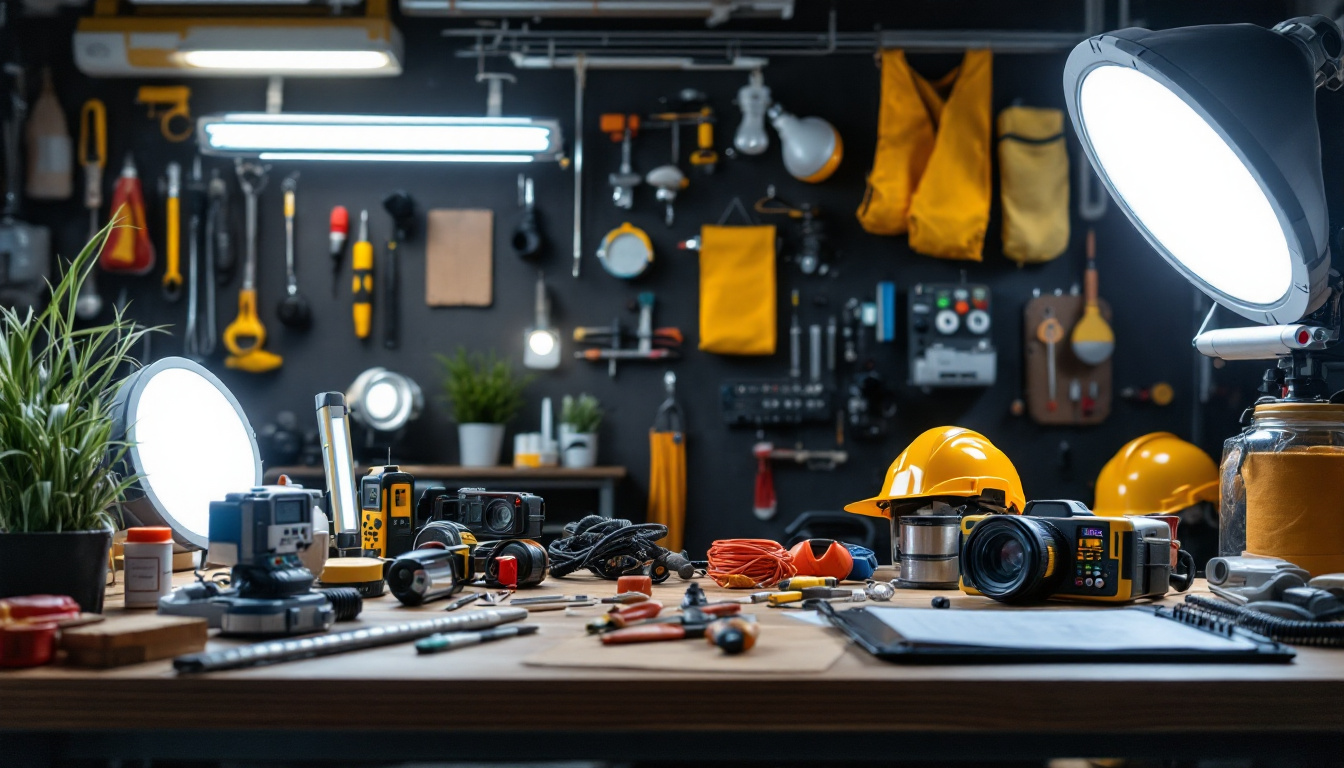
As the lighting industry continues to evolve, contractors are increasingly required to adapt to new technologies and methodologies. The tools available in the market today can significantly enhance efficiency, accuracy, and overall project quality. This article delves into essential tools that every lighting contractor should consider integrating into their workflow.
Before diving into the tools, it’s crucial to grasp the fundamentals of lighting design. This knowledge serves as the foundation upon which contractors can build their projects. Effective lighting design not only illuminates spaces but also enhances aesthetics and functionality. Proper lighting can transform an ordinary room into an extraordinary one, highlighting architectural features, artwork, or landscaping, and creating a welcoming ambiance that invites people to engage with their surroundings.
Lighting contractors must understand various aspects, including color temperature, lumens, and the impact of different light sources. Familiarity with these concepts allows contractors to make informed decisions about the tools they need. Additionally, they should consider the interplay of natural light, which can significantly influence how artificial lighting is perceived. By integrating both natural and artificial light sources, contractors can create a balanced lighting scheme that adapts to different times of day and enhances the overall experience of the space.
Color temperature, measured in Kelvins, affects the mood and functionality of a space. Warm light (around 2700K) creates a cozy atmosphere, while cool light (5000K and above) is energizing and ideal for workspaces. Understanding this can guide contractors in selecting appropriate fixtures and bulbs for their projects. Furthermore, the choice of color temperature can also affect how colors are perceived in a room. For instance, warm light can make colors appear richer and more inviting, while cooler light can enhance the clarity and vibrancy of colors, making it an essential consideration in areas like retail and galleries where color accuracy is paramount.
Lumens measure the total amount of visible light emitted by a source. Knowing how many lumens are required for a specific area is vital for achieving the desired brightness. This understanding helps contractors choose the right fixtures and avoid over or under-illumination. Moreover, it’s important to consider the purpose of the space when determining lumen requirements; for example, a reading nook may require softer, ambient lighting, while a kitchen needs brighter, task-oriented lighting to ensure safety and efficiency. Additionally, the layout and reflective surfaces within a room can affect how light is distributed, making it essential for contractors to assess these factors to optimize lighting performance.
With a solid understanding of lighting design principles, contractors can explore the essential tools that streamline their work. These tools range from software for design to physical instruments for installation and testing.
Modern lighting design software has revolutionized how contractors plan and visualize their projects. Programs such as DIALux and Relux allow users to create detailed lighting layouts, simulate light distribution, and analyze energy efficiency. These tools not only save time but also enhance accuracy in the design process.
Additionally, many software options come with extensive libraries of fixtures, allowing contractors to experiment with different products and configurations. This capability enables them to present clients with realistic visualizations, making it easier to convey ideas and secure approvals.
Accurate measurements are critical in lighting installation. Tools such as laser distance meters and digital lux meters ensure that contractors can measure distances and light levels with precision. A laser distance meter simplifies measuring room dimensions, while a lux meter helps assess existing light levels to determine necessary adjustments.
These measurement tools not only increase efficiency but also reduce the likelihood of costly errors during installation. By ensuring that measurements are accurate, contractors can guarantee that their lighting designs will perform as intended.
Once the design is finalized, having the right installation tools is essential. This includes basic tools like screwdrivers, pliers, and wire strippers, as well as specialized equipment such as conduit benders and cable pullers. Each tool plays a role in ensuring that installations are safe, efficient, and up to code.
Additionally, investing in high-quality tools can lead to better results and increased job satisfaction. Durable tools withstand the rigors of daily use, allowing contractors to focus on delivering quality work rather than dealing with equipment failures.
As technology advances, lighting contractors must stay abreast of new developments that can enhance their services. This includes smart lighting solutions, energy-efficient products, and innovative installation techniques.
Smart lighting systems have gained popularity due to their versatility and energy-saving capabilities. These systems allow users to control lighting remotely, set schedules, and adjust brightness levels through smartphones or voice commands. For contractors, understanding how to install and configure these systems is becoming increasingly important.
Moreover, smart lighting can be integrated with other smart home technologies, providing a comprehensive solution that appeals to tech-savvy clients. Offering these services can set contractors apart in a competitive market.
With growing concerns about energy consumption and environmental impact, energy-efficient lighting has become a priority for many clients. LED technology, for instance, offers significant energy savings compared to traditional incandescent bulbs. Contractors should be well-versed in the benefits and applications of various energy-efficient lighting options.
Incorporating energy-efficient solutions not only helps clients save on utility bills but also aligns with sustainability goals. This knowledge can be a selling point for contractors looking to attract environmentally conscious customers.
Effective project management is vital for the success of any lighting installation. Tools that facilitate communication, scheduling, and budgeting can significantly enhance a contractor’s workflow.
Clear communication is essential in any project. Utilizing platforms like Slack or Microsoft Teams can streamline communication between team members and clients. These tools allow for real-time updates, file sharing, and easy access to project information, reducing the chances of misunderstandings.
Moreover, maintaining open lines of communication fosters collaboration, ensuring that everyone is on the same page throughout the project lifecycle.
Keeping projects on schedule and within budget is a common challenge for contractors. Tools like Trello or Asana can help manage tasks and timelines effectively. These platforms allow contractors to create detailed project plans, assign responsibilities, and track progress.
Budgeting tools, on the other hand, help contractors monitor expenses and ensure that projects remain financially viable. By utilizing these tools, contractors can make informed decisions that contribute to the overall success of their projects.
Safety should always be a top priority for lighting contractors. Working with electrical systems and at heights poses inherent risks, making it essential to have the right safety equipment on hand.
PPE is a fundamental requirement for any contractor. This includes hard hats, safety glasses, gloves, and steel-toed boots. Each item plays a crucial role in protecting workers from potential hazards on the job site.
Additionally, ensuring that all team members are trained in safety protocols can significantly reduce the risk of accidents. Regular safety meetings and training sessions can help reinforce the importance of safety in the workplace.
When working at heights, fall protection gear is essential. Harnesses, lanyards, and safety nets can prevent serious injuries in the event of a fall. Contractors should ensure that all team members are equipped with the appropriate fall protection gear and are trained in its proper use.
Investing in high-quality safety equipment not only protects workers but also demonstrates a commitment to safety, which can enhance a contractor’s reputation in the industry.
The lighting industry is constantly evolving, with new technologies and trends emerging regularly. Staying informed about these changes is crucial for contractors looking to remain competitive.
Subscribing to industry publications, such as Lighting Design + Application or Architectural Lighting, can provide valuable insights into the latest trends, technologies, and best practices. These resources often feature case studies, product reviews, and expert opinions that can help contractors enhance their knowledge and skills.
Additionally, attending trade shows and conferences can offer opportunities to network with peers and learn about new products and innovations firsthand. Engaging with the broader lighting community can inspire new ideas and approaches to projects.
Investing in ongoing education through online courses and certifications can further enhance a contractor’s expertise. Many organizations offer training programs that cover various aspects of lighting design, installation, and technology. These courses can help contractors stay ahead of the curve and offer cutting-edge solutions to their clients.
Furthermore, obtaining certifications can enhance a contractor’s credibility and demonstrate a commitment to professional development, making them more attractive to potential clients.
In the dynamic world of lighting contracting, having the right tools and knowledge is essential for success. From design software to safety equipment, each tool plays a vital role in ensuring that projects are completed efficiently and to a high standard. By staying informed about industry trends and investing in ongoing education, lighting contractors can position themselves as leaders in their field.
Ultimately, the combination of technical skills, effective communication, and a commitment to safety will set successful lighting contractors apart from the competition. By embracing these essential tools and practices, contractors can illuminate their path to success in the lighting industry.
Ready to elevate your lighting projects with the best tools in the industry? Look no further than LumenWholesale for all your lighting needs. Our spec-grade lighting products not only meet the highest industry standards but also come at unbeatable wholesale prices. Say goodbye to local distributor markups and hello to superior lighting solutions that fit your budget. With free shipping on bulk orders, LumenWholesale is committed to providing you with quality, affordability, and convenience in one seamless experience. Don’t compromise on your lighting—choose Wholesale Lighting at the Best Value today and shine brighter with LumenWholesale.

Discover essential insights into the lifespan of fluorescent bulbs and learn strategies to enhance efficiency and client satisfaction.

Discover the charm and functionality of vintage industrial lighting fixtures in your home or workspace.

Discover how ceiling mount lights are transforming spaces with real-world success stories from lighting contractors.

Discover how string work lights can revolutionize the way lighting contractors operate by significantly cutting costs.